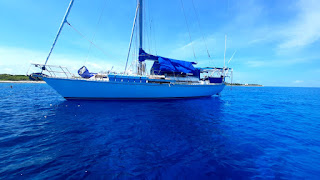Back at Bay Islands, Guanaja and Roatan, May/June 2018
 |
| Dunbar rock. |
The sail from Cuba to Guanaja was uneventful, we had no lures out due to masses of sargassum seaweed islands floating as far as our eyes could see.(see note below)
The wind died already on day two, leaving us on a very frustrating two day motor to Guanaja. Extremely unusual total calm conditions persisted the following 3 weeks, while Cuba faced stormy conditions. (I was relieved that we were not there!)

 |
| Approaching Bonacca/Sheen cay |
We arrived at the same time as catamaran Halcyon, they from Provedencia. Immediately we enjoyed each others company and free-dived together the beautiful reefs of Guanaja. (Some of the most beautiful coral I have seen)
When we could not stand any more the insect-life (no-see-ums) of Guanaja, we motored together to Roatan, stopping at Pigeon cays on the way. (Still absolute calm conditions.)
 |
| Sandy eye-balling at the reef at Pigeon cays. |
 |
| Very seldom possible to anchor here at this spectacular reef. |

Pigeon cays are open to the south-east, making it not possible to anchor here in typical easterlies .
We thoroughly enjoyed an over-night here in this calm crystal clear water and diving these beautiful reefs.
After 2 weeks our paths split with Halcyon, them going on to Belize and us while this calms persisted, returning to Guanaja. For a change to the North-west side.
 |
| Lovely scenery on the North west side of Guanaja, Michael rock. |
 |
| Mmmm a cero catch of the day! |
 |
| Lovely village of Mangrove bight. |
 |
| Mermaid of Carriacou |
 |
| At the entrance to the galley of Mermaid of Carriacou. |
 |
| Love his newly added fold-able dish washing basin . |
We spend a couple of nights at Michael rock anchorage then moved between the reefs on to Mangrove bight where we stayed almost a week visiting our South African friends, Gus and Sally whom recently build a house here.
Another highlight of our time in Guanaja was when Jaco helped John Smith, an eccentric sailor, with Open CPN Charts. 70 year old, John is one of a dying breed of salt stained, single handed Real Sailors.
Although I (Christelle) will never be able to sail on a boat like this, I highly value, appreciate and admire this captain and his wooden, engine-less gaff-rigged sloop, Mermaid of Carriacou.
Quote from his web page: "Exactly why this particular beach-built vessel is so remarkable is difficult to say, yet easily felt once aboard her worn, rough-hewn decks. Her planks - her very bones! - seem to radiate a sense of freedom, contentment and rare possibility"
 |
| View from the cockpit. |
 |
| Relaxed on a dorie bench in front of our friends house. |
When the easterlies came back we sailed to Roatan, Jonesville bight.
Here the dogs love the daily walk in the stunning forest and for variation swimming in the clear water.
After the Jonesville pirate party we sailed to Calabash where we tied up at Ed and Julie's dock. Here Songerie will rest for the next few months while we house- and pet-sit until Ed and Julie return on their monohull yacht sailing from Canada.



 |
| All the prawn and lobster boats are getting ready for the next season starting soon. |
 |
| Small cars for narrow roads. |
 |
| Famous captain Ed at Hole in the Wall bar... love the way every old sailor (whom don't sail any more) call themselves captain! |
 |
| Songerie tied up at her home for at least next 3 months! |

Just before I flew to Namibia, leaving Jaco and the dogs behind for 7 weeks, we met Paul and Marlene. Ex South African and brother-in-law of great friends of Christelle's parents, but moving back to South Africa.
Long story short: we know about him in Honduras for the past 6 years, but never found him until 2 weeks before he left Honduras for the last time!!
We had a lovely BBQ and few wines together aboard Songerie.
I found this interesting article on internet concerning the masses of seaweed.
http://www.sciencemag.org/news/2018/06/mysterious-masses-seaweed-assault-caribbean-islands
Mysterious masses of seaweed assault Caribbean islands
By Katie LanginJun. 11, 2018 , 5:20 PM
In retrospect, 2011 was just the first wave. That year, massive rafts of Sargassum—a brown seaweed that lives in the open ocean—washed up on beaches across the Caribbean, trapping sea turtles and filling the air with the stench of rotting eggs. “It presented immense challenges,” says Hazel Oxenford, a fisheries biologist at The University of the West Indies in Cave Hill, Barbados. Before then, beachgoers had sometimes noticed “little drifty bits on the tideline,” but the 2011 deluge of seaweed was unprecedented, she says, piling up meters thick in places. “We’d never seen it before.”
Locals hoped the episode, a blow to tourism and fisheries, was a one-off. But a few years later “it came back worse,” Oxenford says. Now, the Caribbean is bracing for what could be the mother of all seaweed invasions, with satellite observations warning of record-setting Sargassum blooms and seaweed already swamping beaches. The Barbados government declared a national emergency on 7 June. “It’s catastrophic,” says James Franks, a marine biologist at The University of Southern Mississippi in Ocean Springs, who is one of many scientists trying to explain why a part of the ocean that was once seaweed-free is now rife with Sargassum. “Right now there’s [another] huge mass impacting Puerto Rico, and that’s the last thing they need.”
and more.....












